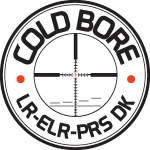
One-Mile Rifle Shooting at Coldbore Range, Denmark by Rod Formosa
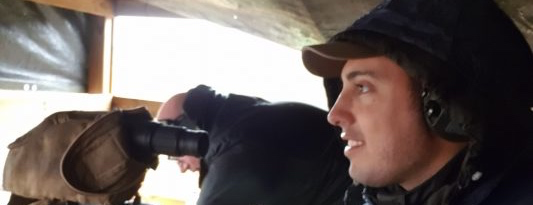
Rod Formosa is a keen shooter and a resident of Malta, though his job has taken him to several countries. He is no stranger to the UK having shot with his friends at Diggle and Bisley in the F Class Europeans. Initially an F Class shooter who got the long-range bug, his interest has now drifted to ELR. Rod’s article first appeared in www.rifletalks.com where you will find a few more photographs of the Denmark trip.
Coldbore Range in Denmark is a military range that goes to 3200m and more. It’s a heaven for one mile shooting and extreme long-range rifle shooting. If you have the right kit, this is the place to stretch its legs. It has an active group of ELR shooters who hold regular competitions. If you check out their website, there’s lots of information on the kit favoured by the ELR crowd.
At the very end of this rifle range there is a white square target measuring 122 x 152cm standing bold at 3.2km – or 2 miles. Can you make that shot?
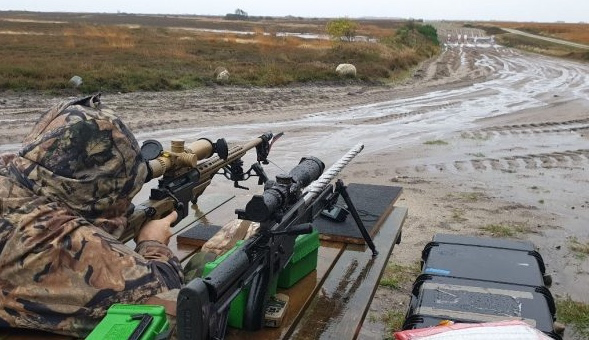
We flew into Billund via Frankfurt – pricey but reliable with Lufthansa (€500 per person tickets including 160 euros rifle handling fee per person). Both Lufthansa and the Danish authorities were superb in handling our firearms. Normal paperwork applies, your European Firearms Pass, your national firearms license as well as the invite and the range booking which Coldbore Range sends you when you book.
We stayed not too far from the range in Skjern in a very good hotel in the town centre for 120 euros per night per person. www.hotelskjern.dk Food there is fantastic and also pricey – like anywhere in Denmark. Food plus wine takes the bill to around 85 euros per person for a meal you would typically pay £40 in Manchester. Car rental is cheaper than UK and we had a large Mondeo estate for €230 for 3 days.
We got to Coldbore range early morning at 7am – bloody pouring rain – worse than Diggle! The range had nothing on it – just two containers with no electricity so we had to set up out our 100m target for zeroing. As dawn broke at 8am we could just make out the targets on the range but rain was getting heavy!
Ever wanted to try and attempt the 1 mile rifle shot? You have probably read about this and even seen numerous video clips of it. So did we… The first time I saw a one-mile shot was probably 15 years ago – rifle legend David Tubb had filmed a one mile shot with his 6.5-284 Win. Years later I talked my shooting buddy Robert into taking up that challenge and build two rifles dedicated for ELR and the One Mile Shot. Rifle work was done by Mik Makismovic of Dolphin Gun Company, UK. www.dolphinguncompany.co.uk
Rifle one:
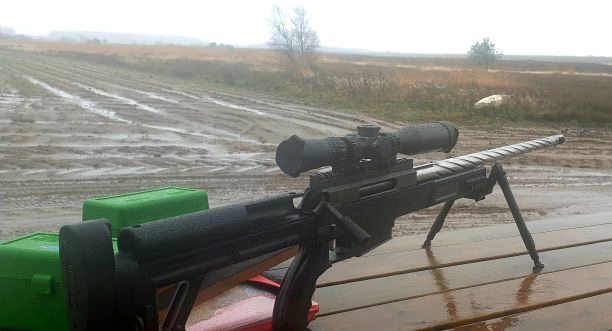
RPA Range Master (UK) originally factory built in 338 Lapua converted by yours truly to 300 Norma Mag.
Action: RPA Rangemaster BMF (huge action and bolt, can take 37XC easily)
Chassis RPA aluminium chassis
Barrel Bartlein 30 inch 1.9twist
Mounts: Tier One one-piece mount
Scope: March 2.5-25×42 MOA/MOA illum. (97MOA of elevation and over 24 MOA of windage)
Bullet: Berger 215gn hybrid at 3250ft/s
Propellant: VV N570, Federal GM215M primers, Lapua Brass
Bipod: Tier One Revolution bi-pod carbon fibre (scroll to bottom of article for picture)
Dolphin 5-port muzzle brake
Rifle two:
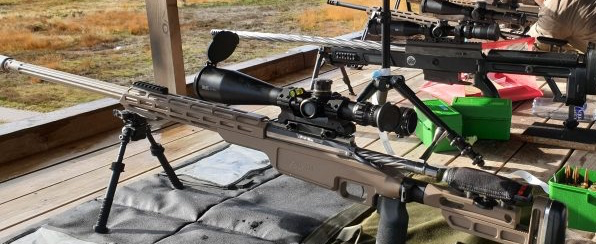
Action:Defiance Deviant action (smooth as silk)
Chassis: Dolphin chassis with folding butt-stock
Barrel: Bartlein 29 inch 1.9 twist throated for 230 Bergers
Mount: Eratac adjustable one piece mount 70MOA
Scope: March 5-50×56
Bullet: 230gn Berger at 3050ft/s
Propellant: VV N570, Federal GM215M, Lapua Brass
Bipod: Accutac later upgraded to Atlas 5h Heavy duty bipod
Dolphin 5-port muzzle break
Rifle three:
Action:Accuracy International 338 Lapua Magnum
Chassis: AI folding stock chassis
Barrel: Lothar Walther 30inch 1.9
Scope: Schmidt Bender 3-20×56 PMII FFP
Bullet: 300gn Berger at 2834 ft/s and Lapua factory 300 grain bullets.
Bipod: Accutac FC G2 bipod
Coldbore Range Targets Overview
David Busch was kind enough to send me this range card for Coldbore Range Denmark. Dave also shoots a 300 Norma Mag slinging Hornady ELD 225grain at 935m/s.

As a military facility run by the Danish Armed Forces, this is quite different from the ranges I’m accustomed to at Bisley Ranges where we shoot F Class. Coldbore is more like the Senny Bridge or Warcop ranges in UK. Huge flat lands stretching more than 3.5 km.
I must commend our range officer, Sandro who was very helpful. He replies to all correspondence on time. He also directed us to a gun shop close to Skjern called Koskov www.koskov.dk It is VERY well equipped, numerous riflescopes, ammo, as well as a very good choice of new and second-hand rifles. We simply loved being there and were feeling our pockets lighten by the minute we spent in there. They stock most factory ammo from Lapua and Norma. Do get in touch with them, they are very nice prople. VAT in Denmark is 25% you’ll notice – that makes 338 Lapua Magnum about €6 each in case you need more than your permitted 5kg of ammo. (5kg equates to about 100 rounds of ammo in 338/300Norma Mag.). They stock a very nice section of high quality Harkila clothing as well as other brands. We were impressed by the large variety of outdoor boots. The Danes seem very eager about their firearms, Sako, Tikka and Sauer rifles lined most of the shelves and very nice ones. A few Sako Trg 22/42 were on display at good prices.
Zeroing our rifles at Coldbore range
We arrived at the range at 7am, it was not too far from where we were staying and after 30 minute drive in open country you arrive at this military facility, greeted by a large sign notifying entrance into a military range.
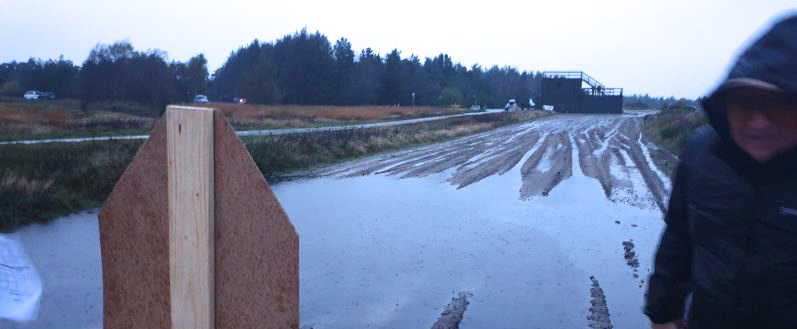
Once we got there we had to setup our own zeroing targets. When we visited in October there was no electricity – in the container that houses the targets or the outside area. I believe Sandro is still working on getting some of these amenities sorted. He was very kind to offer us his Swarovski spotting-scope and Bill was carrying his PLRF10 rangefinder just in case.
We were given four cardboard targets to use as 100m zeroing targets. These needed to be ferried out to the 100m zeroing line and the ground was really messy. Check it out – really wet conditions – we came too far to stop now. Thankfully we had good boots on.
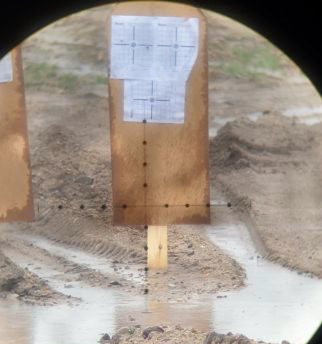
We had three spotting scopes with us plus our rifle scopes. We had to make it fast as pouring rain drenched the targets. We took three shots each and adjusted our scopes to a perfect zero. Thankfully we had a spare turret Allen screw as we lost one in the mud!
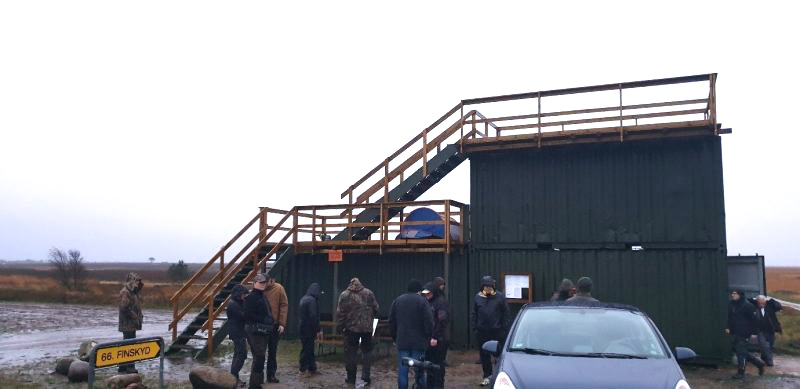
We then climbed up to the tower and set up our rifles. We waited until the first round of shooters got going, and we crammed in near them. Meanwhile they mounted the rain-guard above our heads, which would shield us somewhat from the Danish weather.
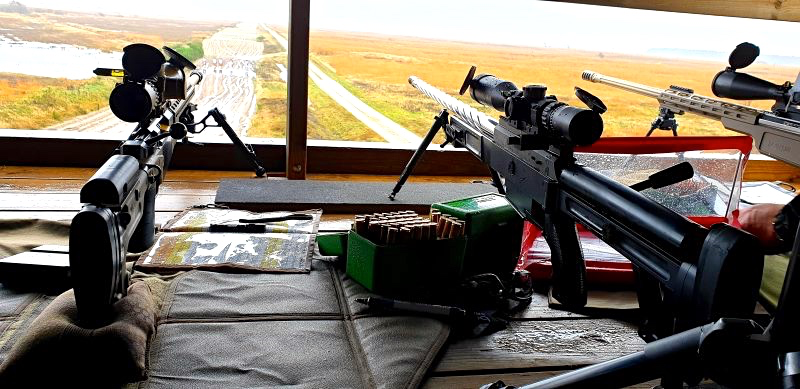
Here we are up in the tower looking at the range ahead of us – a long range rifleman’s dream – kilometres of flat land, although the pouring weather wasn’t as entertaining. Thankfully I’m accustomed to shooting in UK where the weather is often just as testing!
The wind was blowing about 4 mph full value when we first arrived. We had all the data from our live firing just minutes before so we updated that data in our Kestrel.
Our first shot with Rob’s 300 Norma Mag was at 500m. Below you can see the view through my March 2.5-25×42 scope. The 500m target is slightly low.
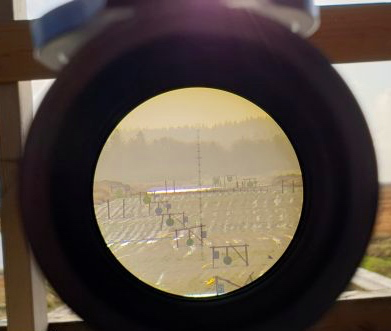
Below you can see challenging shots in very low visibility as rain started pouring. Still Rob is nailing that steel target three times in a row. You can barely make out the faint red flash top left of the 1600m circular steel plate target.
We took advantage of the low wind to send one round at each target starting from 500m then to 800m, 1000, 1250, 1420 and 1600m. We made first round hits on all of these. That put a big smile on our face and some confidence as well. We knew we had good loads from the work we did in Italy over the summer.
Rob and I had only done trajectory validation in Italy at 300, 600 and 1200m so, we were not yet sure if that data was enough. I love how the Kestrel can be setup to show WS1 and WS2 for different wind speeds. I normally set WS2 for 10mph and WS1 for 3mph. Why? Simple. I either work out my correction in fractions of my 10mph wind value (even numbers) or else I work based on my 3 mph wind correction so 3, 6, 9, 12 etc. or fractions of my 10mph wind for say a 5mph wind. I always set Kestrel to show us 10mph wind @ 9 o’clock full value and I work it out from there.
Here you can see a better view through my spotter on 30x magnification with the treeline of Coldbore Range in the distance.
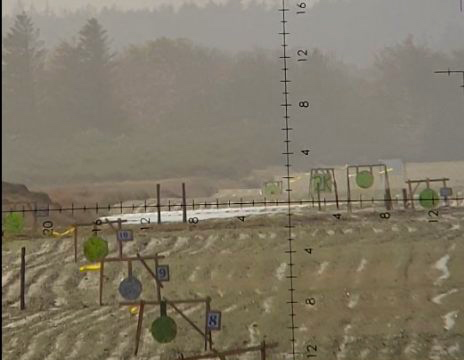
Swarovski ATS 65x objective with 30x Vortex optics MOA reticle lens
Visibility drops once the weather takes a turn for the worst. Rob still made hits in these conditions.
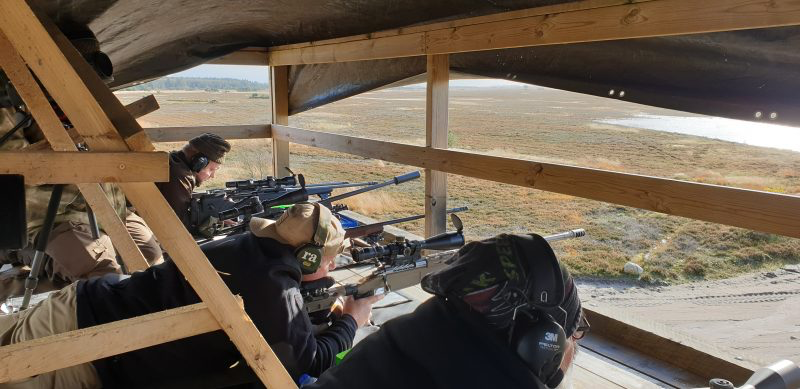
Space is in short supply here – big rifles in confined spaces with big blasts. I must admit that after a few shots in here, the concussion was becoming a little too much so I moved out for some fresh air.
Targetry at Coldbore Range
The targetry at Coldbore Range is very good. You won’t hear the far plates ringing, they are immensely heavy and don’t ring like other plates we’ve shot before but they are connected to a flashing light that turns red when hit. The weather didn’t help much and at some point we were not sure whether we had a hit or not on the 1 mile target.
After Rob did his string we switched roles and he was spotting for me while I was doing the shooting. Wind started picking up and we worked out our first few shots on an 8mph wind correction from 8 o’clock at 0.8 value. We made a first round hit on the 500, 800, 1000, 1250 and 1420m but missed the one mile target – slightly right of target.
The 3 second flight time was enough to spot my miss and for the next round I favoured a left hold on the target backer and sent one down as fast as I could. That second shot impacted the target – confirmed by a lit up flashlight. It brings a big smile on your face – the preparation was paying dividends. Rob managed 3 hits in a row on the 1 mile target, while I managed 2 out of 3. The 300 Norma is very consistent at this distance in stable winds.
I had tested this load for vertical dispersion at 1200 yards and it was holding 5 inches of vertical at that distance. Unfortunately here there was no electronic target at 1 mile and neither a camera to be able to gauge the vertical dispersion of our group – a key component in making shots at these ranges.
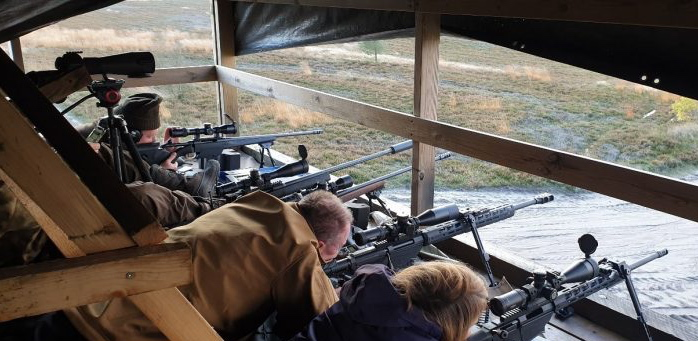
Full house on the top level of the firing tower! Seen here is a Ruger 338 Lapua Magnum rifle
We took a short break after our second round to let the barrels cool. At these velocities, the barrels ‘toast’ quickly so typically I shoot 3 – or maximum 5 rounds and let it cool. The firing-line was pretty congested too and those muzzle brakes blasting off just a metre right and left are not very neighbour-friendly.
I noticed that very few shooters were actually making any calculations before the shot and I figured a few were ‘chasing spotters’ as we call it in F Class. In this case, there was no spotter so they were chasing ‘misses’. A few others were shooting way too fast in my opinion for 338 Lap Mag and without any form of plotting their shots. This turns the game into an expensive gamble lacking skill in my view. Maybe that’s just my approach coming in from F Class.
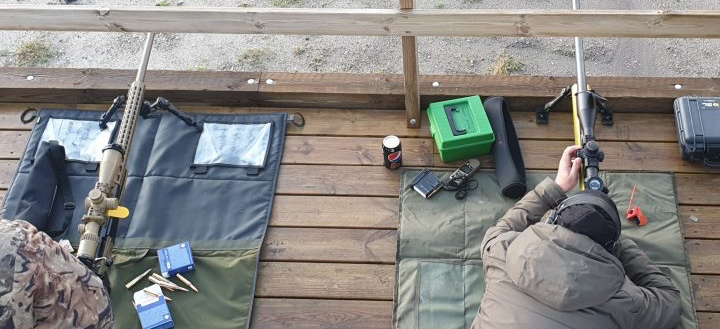
Bill nestled himself beneath us and was engaging a few targets up close, validating his trajectory.
We retired into the car for a lunch break and some tea. There aren’t any food outlets on Coldbore Range so we suggest stopping at one of the town’s bakeries and grab a chicken bun before you head out here. The rain kept pouring and at some point it was virtually impossible to see further than 1000 yards. The 2 km target fell over so we could not take a shot at it. We had travelled so many thousands of miles, we should have started with the 2 km target first when the weather was calmer! In the afternoon we had a few hail showers, which made the ground even wetter than when we arrived. This almost gobbled up our bullets when they impacted the ground. Spotting misses at 2 km was impossible. Occasionally we would see faint splashes. I would say it is comparable to shooting sighter shots in the wet sand at Bisley with a 308 at 1000 yards.
Day two at Coldbore Range
On Sunday morning the weather was slightly better – still pouring but this time we could see the target at 2 km. The rain during the night had soaked the ground pretty good around the target. There was a puddle around the 2 km target but we couldn’t tell how close or far it actually was from the target.
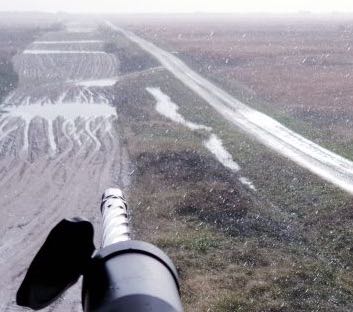
The wind was 12mph and started gusting to 18mph. We tried timing the shots but when we managed to see the impact we were bouncing around the target – sometimes very close other times way off. Occasionally the sun would come out making it easier to see the targets and impacts in the ground. Here’s where larger calibers like the 37XC and 416 Barrett play a useful role – in enabling you to see the splash when you miss. Pretty sure if we were shooting on dry soil as in Italy, the impacts would be visible with the 300 Norma. Rob took a few shots at the 2 km target on day two. You’re effectively looking at spotting a splash of maybe 40 cm from 2 km away. Clear conditions are an immense help to the spotter.
At 2 km in these conditions without camera on the target it was a gamble. If I missed 3 shots in a row, I cut down on distance and went to the 1420m target. Some conditions make one mile possible, others are simply not ideal for a 2 km shot. That additional 300m out to one mile takes it to another level.
How is recoil on a 300 Norma Mag?
There’s virtually no recoil on a setup like this. The Dolphin muzzle break does a very good job, coupled with a 9kg rifle.
As the afternoon progressed the winds just blew stronger and, at one point, lifted the canopy above our head and tumbled the supporting bracket holding it. Luckily it fell behind me. I clocked this wind at 23 mph. We could still engage the targets at 1250 m with relative ease (60cm radius) believe it or not. We took a shot at the 800m plate in this wind and we overcompensated! A string of shots at 2 km had given us another taste of the wind correction. Lesson learnt, don’t underestimate the closer range targets especially after you’ve been shooting at serious distances. Fantastic moments with good friends, that’s what the sport is all about whilst pushing our kit to the next level.
Overall I shot 80 rounds during this weekend. Mainly between 1000 and 2000 meters. Here are some conclusions on our set-up and what we shall be improving.
- Spotting is as important as shooting, the better the spotting-scope and spotter the better your chances are. Our Manfrotto tripod is good and lightweight but in winds like these makes the spotter shake. Ideally you would have a binospotter like the BTX. It is more comfortable for longer shooting sessions where you are really trying to spot small splashes…
- Lower heavier tripod helps in minimizing spotting-scope shake.
- Try the furthest target first when conditions are still calm. It may not be there later!
- Heavy rounds help, shoot the heaviest calibre you can afford to shoot
- There are one mile conditions and 1000m conditions.
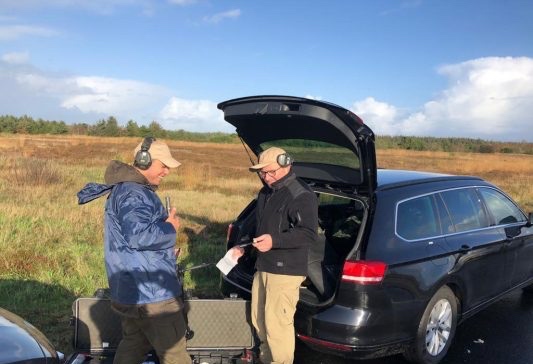
Finally, we all received our ‘Coldbore Range Denmark’ badge. It was rewarding as well as making us hungry for more ELR action. Thanks Sandro for having us over!
After this trip we made some minor modifications to our bipods as well. I love my Tier One Evolution bipod, it’s a great field bipod. For really precise long-range work in very windy conditions, a heavier one helps. The LRA is bulky but provides that wider stance.
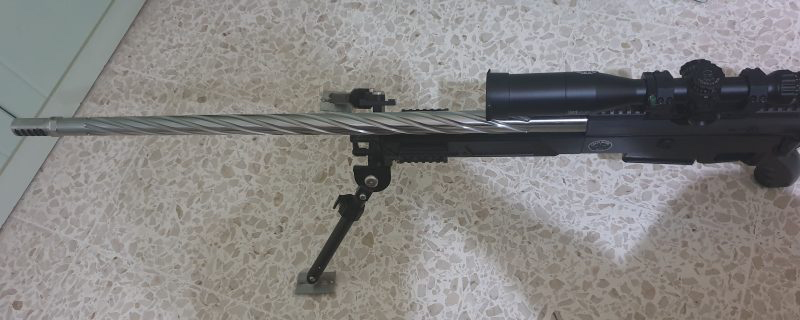
Rob also upgraded his bipod to a heavier Atlas 5h bipod.
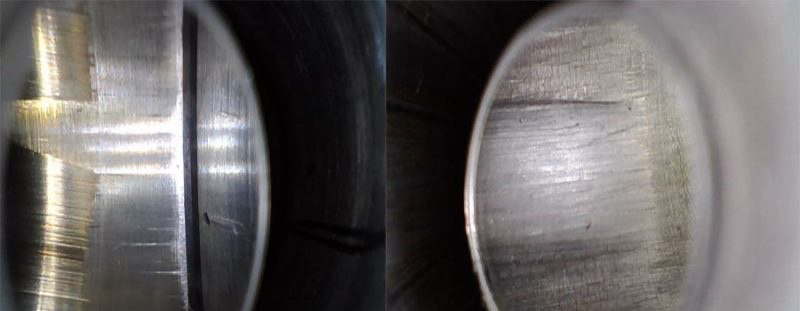
Ever wondered what 90 grains of powder does to a brand new Bartlein barrel after 120 rounds? Barrel when new – barrel after 120 rounds.
Interested in making the one mile or even 2 mile shot at Coldbore Range in Denmark? Contact Sandro via www.coldborerange.dk/home/contact/

